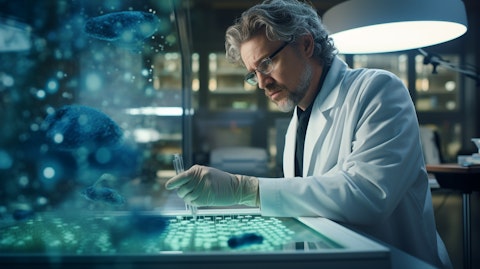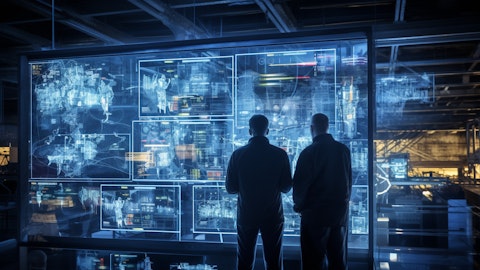Seres Therapeutics, Inc. (NASDAQ:MCRB) Q2 2025 Earnings Call Transcript August 6, 2025
Seres Therapeutics, Inc. beats earnings expectations. Reported EPS is $-2.27, expectations were $-2.72.
Operator: Good morning, and welcome to the Seres Therapeutics Second Quarter 2025 Results and Business Update Call. [Operator Instructions] Please note, this call is being recorded. I would now like to turn the conference over to Dr. Carlo Tanzi, of Investor Relations. Please go ahead.
Carlo Tanzi: Thank you, and good morning. Our press release with the company’s second quarter 2025 financial results and business updates became available at 7:00 a.m. Eastern Time this morning and can be found on the Investors and News section of the company’s website. The company has also posted an updated corporate presentation to the website. I’d like to remind you that we’ll be making forward-looking statements, including statements about the timing and results of our clinical studies and data readouts, future product candidates, clinical development plans and commercial opportunities, communications with feedback from or submissions to the FDA, operating plans and our future cash runway, future obligations related to the VOWST sale, our ability to secure a business development deal, partnerships and/or generate or obtain additional capital or financing, our planned strategic focus, anticipated timing of any of the foregoing and other statements, which are not historical fact.
Actual results may differ materially. Additionally, these statements are subject to certain risks and uncertainties, which are discussed under the Risk Factors section of our recent SEC filings. Any forward-looking statements made on today’s call represent our views as of today only. We may update these statements in the future, but we disclaim any obligation to do so. On today’s call, with prepared remarks, I’m joined by Marella Thorell, Co-CEO and CFO; and Matthew Henn, Chief Scientific Officer. Additional members of the management team, including Tom DesRosier, Co-CEO and Chief Legal Officer; Terri Young, Chief Commercial and Strategy Officer; and Dennis Wally MD, Senior Medical — Senior Vice President of Clinical Development, will also be available during the Q&A portion of the call.
And with that, I’ll pass the call on to Marella.
Marella Thorell: Thank you, Carlo, and good morning, everyone. Today, we’ll share recent business highlights, progress on SER-155 development activities and an update on our efforts to obtain additional resources to enable continued advancement of our programs. Seres has continued making meaningful progress toward our mission of bringing novel live biotherapeutic products to patients in need. Our efforts and results to date have clearly demonstrated both the therapeutic power of this modality with highly compelling clinical data sets and 2 breakthrough therapy designations achieved and Seres capabilities to successfully obtain FDA approval. Looking ahead, we are optimistic about the promise of our live biotherapeutics to provide transformative clinical benefits to patients including for serious infections and inflammatory diseases that affect a large patient population.
We have advanced preparation of SER-155 for the next stage of development. As a reminder, our previously completed SER-155 Phase Ib study provided highly promising results that supported continued development. The study showed that SER-155 administration resulted in a 77% relative risk reduction in bloodstream infections compared to placebo in patients undergoing allogeneic hematopoietic stem cell transplant or allo-HSCT, resulting in a number needed to treat of 3 to prevent 1 bloodstream infection. This represents a compelling outcome for this high-risk patient population in need of better options. SER-155 was generally well tolerated in the study, consistent with the placebo-like safety profile we’ve seen historically across our live biotherapeutic product platform.
The clinical results generated to date underscore the potential of SER-155 to redefine the standard of care for allo-HSCT recipients and many other vulnerable patient groups at risk of bloodstream infections. Guided by our constructive FDA feedback, we submitted a Phase II protocol to the FDA. we are pleased with the productive interactions we’ve had with the FDA to date, which have been facilitated by SER-155 having breakthrough therapy designation. The FDA has remained highly engaged and has indicated that they will provide further feedback on the protocol in the near future, which we expect will support finalizing the study design. The proposed Phase II study is designed to be a well-powered, placebo- controlled study with an enrollment goal of approximately 248 participants undergoing allo-HSCT and with the primary endpoint of prevention of bloodstream infections.
The study employs an adaptive design with an interim data analysis once approximately half of the enrolled participants have reached the primary endpoint. Based on our operational plans and anticipated enrollment, we believe we could obtain interim results within 12 months of study initiation, thereby rapidly informing next steps in allo-HSCT development, including potential engagement with the FDA on the design of a registrational study. Those data could also support the pursuit of additional clinical development opportunities targeting adjacent patient populations at elevated risk of bloodstream infections such as patients undergoing autologous-HSCT. We believe these indications as well as additional target populations that we have discussed in the past represent multiple substantial commercial opportunities for Seres.
If successful, we expect that the results from the planned Phase II study would represent a very meaningful value inflection point for the company and could support advancing to a single registrational study for approval of SER-155 in allo-HSCT. In conjunction with the development of the study protocol, we have continued to progress operational preparations for the study, including commencing study start-up activities with our CRO and advancing the manufacture of clinical supply. We are optimistic about the prospects for SER-155 and our broader pipeline. We are also mindful of the capital and resources required to effectively advance these programs as well as the continued challenging biotech environment. Our immediate top corporate priority is to obtain capital to enable our promising development candidates, starting with SER-155 to progress to meaningful clinical milestones.

The types of transactions we are evaluating include partnerships, out-licensing deals, mergers, and other types of structures with counterparties who could provide capital and other resources and which aim to leverage Seres’ expertise and track record in successfully bringing a live biotherapeutic product to the market. We are in active discussions with multiple parties aiming to secure a deal. In conjunction with these efforts, we also continue to evaluate potential cost reduction actions to extend our cash runway. With that, I’ll turn the call over to Matt to discuss recent scientific progress.
Matthew R. Henn: Thanks, Marella. I’d like to review some of our recently presented data from our SER-155 and additional biotherapeutic programs. At the May ASCO meeting, we presented new exploratory biomarker data from the SER-155 Phase Ib study. These biomarker data provided evidence of the potential of SER-155 to promote immune reconstitution following allo-HSCT through the modulation of homeostatic cytokines and peripheral T-cell expansion. The results highlight the potential role of SER-155 in promoting peripheral T-cell recovery and immune reconstitution to support favorable outcomes post allo-HSCT. Based on the SER-155 clinical results to date as well as our other mechanistic data, we believe that SER-155 could provide benefit to a range of patient populations at risk of bloodstream infections and other conditions.
I’d like to also provide an overview of our recent activities focused on the development of our live biotherapeutics for the treatment of inflammatory and immune diseases. In May, we presented data at the Digestive Disease Week conference that reported the identification of biomarkers that can identify patients with microbiome driven disease and that can predict response to both existing IBD therapeutics and live biotherapeutic interventions. We were pleased to see that our poster entitled Candidate Biomarkers of Microbiome Disruption for Patient Selection or Stratification in Clinical Trials of microbiome therapies in ulcerative colitis, received a poster Distinction Award in the Microbiome and Microbial Therapy subgroup. We believe that the findings presented support the potential of live biotherapeutics as a novel treatment modality for gut-related inflammatory and immune diseases and suggest that sizable patient subpopulations well-suited for this approach may be identifiable.
In conjunction with the partnership opportunities that Marella mentioned, we are exploring potential R&D partnerships to advance our development of our investigational live biotherapeutics in inflammatory and immune diseases, including ulcerative colitis and Crohn’s disease. These conditions impact large patient populations and biotherapeutics could provide a therapeutic approach that is highly differentiated from other drugs that are currently in use or in development with opportunities for both monotherapy and combination therapy. Additionally, the company is collaborating on an investigator-sponsored trial with Memorial Sloan Kettering Cancer Center to evaluate the use of SER-155 for immunotherapy-related enterocolitis, also referred to as IREC.
Seres is providing investigational product for the study. IREC is among the most frequent and severe immune-related adverse events and recipients of immune checkpoint inhibitor therapy and is observed in 35% to 50% of patients undergoing this cancer treatment. Immune checkpoint inhibitors can cause a wide range of immune-related adverse events linked to T-cell biology and epithelial barrier inflammation, biological functions known from our preclinical studies and clinical pharmacology data to be positively impacted by SER-155. Positive data from this study would provide further support for the expansion into additional indications likely well suited for our biotherapeutic approach. With that, I’ll turn the call back to Marella.
Marella Thorell: Thank you, Matt. I’ll now turn to second quarter financial results. As a reminder, Seres has classified all historical operating results for the VOWST business within discontinued operations in the consolidated statements of operations for the comparative periods presented, and there was no activity in this quarter related to discontinued operations. Seres reported a net loss from continuing operations of $19.9 million in Q2 2025, as compared to $26.2 million in the second quarter of 2024. Research and development expenses for this quarter were $12.9 million compared to $15.8 million in the second quarter of 2024, reflecting lower costs related to the completion of the SER-155 Phase Ib study, lower personnel expenses, and a decrease in platform investments.
General and administrative expenses were $10.3 million in the quarter compared to $13.1 million in Q2 2024, driven primarily by lower personnel and related expenses including IT related. In July, we received the $25 million installment payment due from Nestlé as expected. As of June 30, 2025, we had cash and cash equivalents of $45.4 million. Based upon our current cash balance, the $25 million payment received, VOWST transaction-related obligations and current operating plans, we expect to be able to fund operations into the first quarter of 2026. We have implemented and continue to evaluate potential cost reduction actions to extend our cash runway. As I conclude, Tom, I, and the entire Seres team would like to take a moment to acknowledge and thank Eric Shaff for his significant contributions to the company over the past decade.
During Eric’s tenure, Seres led the maturation of the biotherapeutic field and successfully delivered the first ever FDA-approved oral microbiome therapy to patients. We are pleased to continue benefiting from Eric’s perspective as he remains a member of the Seres Board. We also welcome Rob Rosiello, an executive partner at Flagship Pioneering, who will be joining our Board and Paul Biondi also a flagship, transitions off. We thank Paul for his service on the Board. To summarize, we are making good progress advancing SER-155 to enable readiness for the Phase II study. We are also progressing our efforts to secure capital and resources to enable the continued development of SER-155 that could capture substantial therapeutic and commercial opportunities.
Operator, you may now open the call for questions.
Q&A Session
Follow Seres Therapeutics Inc. (NASDAQ:MCRB)
Follow Seres Therapeutics Inc. (NASDAQ:MCRB)
Receive real-time insider trading and news alerts
Operator: [Operator Instructions] Your first question comes from the line of Joseph Thome with TD Cowen.
Joseph John-Charles Thome: Maybe the first one, just on the potential deals. You obviously indicated a various amount of options with different structures here. I guess how will you decide the best structure for Seres when finishing up a deal, a potential deal going forward? What would be the ideal structure for the team and the investor base in your opinion? And then second, I saw in the corporate deck that you highlighted encouraging feedback from European physicians on SER-155. I guess is there plans to include the EU in the Phase II? And do you believe that the [indiscernible] would accept the trial design that you’ve been going back and forth on with the FDA.
Marella Thorell: Great. Good morning, Joe, thank you for your questions. First, with respect to the structure of a BD deal, yes, we are exploring a number of different structures, and there are many types that could make sense for the company. In the first instance, we’re looking for an opportunity that provides capital to meaningfully advance our SER-155 program. There also are various capabilities that counterparties bring that would be helpful and additive to our resources and experience, for example, experience conducting a global study. There are also structures, we mentioned mergers as a potential where we could also leverage or the counterparty could leverage the expertise and success that Seres has had getting a product approved through the FDA in the microbiome field. But I’ll also offer my co-CEO, Tom, to provide his thoughts.
Thomas J. DesRosier: Yes, sure. Thanks, Marella. Joe, as you recall, for months, we’ve been talking about our 155 partnership process and that continues. We are having discussions with companies about a somewhat simple partnership process with 155, but interestingly, during that process, a banker called us and suggested that maybe as the leader in the space with all the success we’ve had with FDA that maybe we would be interested in leading a roll-up of the microbiome company space. That seemed to us to be a bit too complex, but it did get us thinking that perhaps a merger with a live biotherapeutic company with clinical stage assets and a new different set of investors might be an interesting thing to explore, particularly a company who needs our expertise in clinical and regulatory manufacturing.
So we actually reached out to a few. And coincidentally or maybe not coincidentally, one reached out to us, and we continue to be in multiple discussions on such a merger. Of course, your question, what would be best for us, we are certainly looking for substantial financial support for what we’re doing. And in any such of a merger process, we would need to have it be financeable. But we’re optimistic, given the activity that we have going now, we’re optimistic that we’ll have a deal to decide whether to do and maybe multiple deals to pick from. I’d also say it’s been really interesting to hear Commissioner McCari talk about the importance of microbiome, healthy microbiome in the health of the population. And we’re excited that FDA is so excited about the microbiome opportunity.
So we remain optimistic. As Marella said, the market is tough out there, no guarantees, but we’re going to continue to work hard on our BD process.
Marella Thorell: Thanks, Tom. And your second question regarding EU feedback, yes, we had robust interaction with EU KOLs. Phase II study will be a global study, including European countries. Importantly, the design of the Phase II study is very robust. It’s well powered. And so we are excited about the potential receptivity of EMEA, whom we will engage at the appropriate time regarding the study design. But I’ll ask Dennis if he has any further comments to add.
Dennis M. Walling: Yes. Thank you, Marella. I would like to add that we did have a number of engagement conversations with KOLs in the EU. And we heard the same message that we have heard from our U.S.-based KOLs that is bloodstream infections in this allo-HSCT population are still a major problem and a major unmet need. And every one of them was absolutely excited to be able to participate in a study looking at SER-155 with such a novel approach to a problem that has not been solved yet.
Operator: That concludes our Q&A session. I will now turn the call back over to the management for closing remarks.
Marella Thorell: Thank you very much for joining the call today, and have a great day.
Operator: That concludes today’s call, ladies and gentlemen. Thank you all for joining. You may now disconnect. Everyone, have a great day.
Follow Seres Therapeutics Inc. (NASDAQ:MCRB)
Follow Seres Therapeutics Inc. (NASDAQ:MCRB)
Receive real-time insider trading and news alerts





